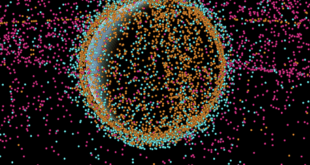By Luisa Low

During this week’s Space Café, SpaceWatch.Global Publisher Torsten Kriening caught up with Emmanuelle David, the Executive Manager of EPFL Space Center (eSpace) and Dr Minoo Rathnasabapathy, a Research Engineer within the Space Enabled Research Group at the MIT Media Lab.
Having studied her undergraduate degree and doctorate at RMIT University in aerospace, aeronautical and astronautical/space engineering, Dr Minoo Rathnasabapathy is an expert in space, having spent the last 16 years working across Europe and the US, including as Executive Director of the UN’s Space Generation Advisory Council and now as a Research Engineer at MIT in Boston.
With a career spanning thirteen years in the space sector, and an education in mechanical and aerospace engineering, Emmanuelle David began her career at the European Space Agency before working in various engineering roles at DLR. She then joined Swiss technology group RUAG International as Launch Campaign manager, managing engineering operations in French Guyana, before joining the EPFL Space Centre in 2020, where she now leads strategy, implementation and research into sustainable space logistics.
This week, Dr Rathnasabapathy, Ms David and Torsten discuss global efforts to cultivate a safe and sustainable space.
Defining and maintaining space sustainability
In 2021, the EPFL was selected to host and operate the Space Sustainability Rating with a timeline to commence operations in early 2022. With escalating tensions undermining the establishment global consensus, how can the future of space be ensured?
According to Emmanuelle, there there is no real consensus – or definition – on what constitutes space sustainability. The UN has based its guidelines on a broad definition of space sustainability: maintaining the conduct of space activities into the future and allowing for continued equitable access.
“Space sustainability is defined as the ability to maintain the conduct of space activities indefinitely into the future,” Emmanuelle David said.
But is this enough to keep pace with the ever-growing space and launch industry?
According to Dr Rathnasabapathy, legislation and safeguards are not keeping up with the pace of change in the industry.
“We’re all very aware that we are increasingly dependent on space technologies in every way in every day of our lives. And if we consider the projected growth of space sectors, the miniaturization of technologies, the rise in commercial space activities, and the fact that there are lower satellite development and launch costs, it’s really in stark contrast to the pace of development of some of these regulatory guidelines and norms of behaviour.”
How SSR works
The first rating of its kind in the space industry, the Space Sustainability Rating was conceived in 2017 at the Global Future Council discussions and was later formed in 2019 by a consortium including ESA, the University of Texas at Austin and Bryce Space and Technology. In 2021 EPFL was selected as its administrative organisation.
The rating was designed to bridge the gap between the growing industry and lagging legislation, “to recognise and reward actors who are actively going above and beyond in the pursuit of long term sustainability.”
Will it work?
The competition to feature favourably and maintain a reputation can be a great motivator. In other industries, ratings can have a profound effect on curtailing corporate behaviour, influencing industries to do better even in the absence of firm regulation.
“One of which that we quote quite often is the LEED rating system that’s used on the building industry, so thinking about how buildings are manufactured and, and how sustainable the use of the building and energy efficient the building is. So taking that concept and applying it to the space industry to really assess how sustainable satellites and space missions are,” said Dr Rathnasabapathy.
How does EPFL administer the ratings?
The Space Sustainability Rating is predicated on a scoring system that looks at six different modules.
According to the World Economic Forum, Scores are based on factors ranging from data sharing, ability to verify information, choice of orbit, measures taken to avoid collisions, plans to de-orbit satellites on completion of missions, and even how well they can be detected and identified from Earth.
“So the rating is assessing positive behaviour – we’re focusing on what is good,” said Emmanuelle.
As administering organisation, EPFL is focused on engaging the broader space community and promoting qualified knowledge on sustainability. Coming from neutral Swiss ground, it appears the research organisation is well equipped to do this.
“So in the design and development of the SSR, we knew that we wanted it to be a global rating system that could be applied to any sector. So again, whether it’s the commercial side or government side, and we also wanted it to be international. So having an academic institution that represented that neutrality was a key factor in the selection process,” said Dr Rathnasabapathy.
Rather than come from a critical perspective, SSR was established to collaboratively bring on board on a range of stakeholders.
“So when we first started thinking about what the SSR looked like, or would look like, one of the key things that we started is having stakeholder meetings and again, through different sectors of the industry, from government and agency to industry. And we wanted to ensure that the first iteration of the SSR meant that everybody felt like they were included in the discussions, even though the priorities are quite different, depending on which part of the space sector you represent.”
To listen to Dr Minoo Rathnasabapathy and Emmanuelle David’s insights into the Space Sustainability Ratings, you can watch the full program here:
Luisa Low is a freelance journalist and media adviser from Sydney, Australia. She currently manages Media and Public Relations for the University of Sydney’s Faculty of Engineering.





